Analysis of Convergence Characteristics of Average Method Regulated by ISO 9869-1 for Evaluating In Situ Thermal Resistance and Thermal Transmittance of Opaque Exterior Walls
Abstract
1. Introduction
2. Methods
2.1. Investigated Building
2.2. In Situ Measurement
2.3. Data Analysis
3. Results and Discussion
3.1. Evolution of -Value and -Value
3.2. Effect of Variation in Analysis Period
3.3. Effect of Temperature Difference
4. Conclusions
Author Contributions
Funding
Conflicts of Interest
Nomenclature
| Test duration, days | |
| Functional relationship between measurand and input quantities on which measurand depends | |
| Integer part | |
| Individual measurements | |
| Number of measurement data points | |
| Number of input quantities on which measurand depends | |
| Density of heat flow rate, W/m2 | |
| Thermal resistance value evaluated by average method, m2·K/W | |
| Interior surface resistance, m2·K/W | |
| Exterior surface resistance, m2·K/W | |
| . | Material thickness, m |
| Exterior air temrature, K | |
| Interior air temperature, K | |
| Exterior wall surface temperature, K | |
| Interior wall surface temperature, K | |
| Combined standard uncertainty | |
| Standard uncertainty of input estimate | |
| Thermal transmittance value evaluated by average method, W/m2·K | |
| Thermal transmittance value evaluated by calculation method, W/m2·K | |
| th input quantity on which measurand depends | |
| Estimate of input | |
| Measurand | |
| Estimate of measurand | |
| Thermal conductivity, W/m·K |
References
- Ministry of Land, Infrastructure and Transport (MOLIT). Energy Saving Design Standards for Building; Ministry of Land, Infrastructure and Transport: Sejong, Korea, 2017. Available online: http://www.molit.go.kr/USR/I0204/m_45/dtl.jsp?idx=15270 (accessed on 19 February 2019).
- ISO 6946:2007—Building Components and Building Elements—Thermal Resistance and Thermal Transmittance—Calculation Method. Available online: https://www.iso.org/standard/65708.html (accessed on 19 February 2019).
- Choi, D.S.; Ko, M.J. Comparison of various analysis methods based on heat flowmeters and infrared thermography measurements for the evaluation of the in situ thermal transmittance of opaque exterior walls. Energies 2017, 10, 1019. [Google Scholar] [CrossRef]
- ISO 9869–1:2014. Building Elements—In-Situ Measurement of Thermal Resistance and Thermal Transmittance—Part 1: Heat Flow Meter Method. Available online: https://www.iso.org/standard/59697.html (accessed on 19 February 2019).
- Adhikari, R.S.; Lucchi, E.; Pracchi, V. Experimental measurements on thermal transmittance of the opaque vertical walls in the historical buildings. In Proceedings of the 28th International PLEA Conference on Sustainable Architecture + Urban Design, Lima, Peru, 7–9 November 2012. [Google Scholar]
- Cabeza, L.F.; Castell, A.; Medrano, M.; Martorell, I.; Perez, G.; Fernandez, I. Experimental study on the performance of insulation materials in mediterranean construction. Energy Build. 2010, 42, 630–636. [Google Scholar] [CrossRef]
- Asdrubali, F.; D’Alessandro, F.; Baldinelli, G.; Bianchi, F. Evaluating in situ thermal transmittance of green buildings masonries—A case study. Case Stud. Constr. Mater. 2014, 1, 53–59. [Google Scholar] [CrossRef]
- Evangelisti, L.; Guattari, C.; Gori, P.; Vollaro, R.D.L. In situ thermal transmittance measurements for investigating differences between wall models and actual building performance. Sustainability 2015, 7, 10388–10398. [Google Scholar] [CrossRef]
- Baker, P. U-Value and Traditional Buildings: In Situ Measurements and Their Comparisons to Calculated Values; Historic Scotland Technical Paper: Edinburgh, UK, 2011. [Google Scholar]
- Rye, C.; Scott, C. The SPAB Research Report 1: U-Value Report. Society for the Protection of Ancient Buildings, London. 2012. Available online: https://www.spab.org.uk/sites/default/files/documents/MainSociety/Advice/SPABU-valueReport.Nov2012.v2.pdf (accessed on 19 February 2019).
- Bros-Williamson, J.; Carnier, C.; Currie, J.I. A longitudinal building fabric and energy performance analysis of two homes built to different energy principles. Energy Build. 2016, 130, 578–591. [Google Scholar] [CrossRef]
- Gaspar, K.; Casals, M.; Gangolells, M. In situ measurement of façades with a low U-value: Avoiding deviations. Energy Build. 2018, 170, 61–73. [Google Scholar] [CrossRef]
- Ahmad, A.; Maslehuddin, M.; Al-Hadhrami, L.M. In situ measurement of thermal transmittance and thermal resistance of hollow reinforced precast concrete walls. Energy Build. 2014, 84, 132–141. [Google Scholar] [CrossRef]
- Ficco, G.; Iannetta, F.; Ianniello, E.; d’Ambrosio Alfano, F.R.; Dell’Isola, M. U-value in situ measurement for energy diagnosis of existing buildings. Energy Build. 2015, 104, 108–121. [Google Scholar] [CrossRef]
- Deconinck, A.H.; Roels, S. Comparison of characterization methods determining the thermal resistance of building components from onsite measurements. Energy Build. 2016, 130, 309–320. [Google Scholar] [CrossRef]
- Gaspar, K.; Casals, M.; Gangolells, M. Review of criteria for determining HFM minimum test duration. Energy Build. 2018, 176, 360–370. [Google Scholar] [CrossRef]
- ASTM C 1155. Standard Practice for Determining Thermal Resistance of Building Envelope Components from the In-Situ Data. Available online: https://www.astm.org/Standards/C1155.htm (accessed on 19 February 2019).
- Haralambopoulos, D.A.; Paparsenos, G.F. Assessing the thermal insulation of old buildings—The need for in situ spot measurements of thermal resistance and planar infrared thermography. Energy Convers. Manag. 1998, 39, 65–79. [Google Scholar] [CrossRef]
- Balaras, C.A.; Argiriou, A.A. Infrared thermography for building diagnostics. Energy Build. 2002, 34, 171–183. [Google Scholar] [CrossRef]
- Ocana, S.M.; Guerrero, I.C.; Requena, I.G. Thermographic survey of two rural buildings in Spain. Energy Build. 2004, 36, 515–523. [Google Scholar] [CrossRef]
- Kalamees, T. Air tightness and air leakages of new lightweight single-family detached houses in Estonia. Build. Environ. 2007, 42, 2369–2377. [Google Scholar] [CrossRef]
- Taylor, T.; Counsell, J.; Gill, S. Energy efficiency is more than skin deep: Improving construction quality control in new-build housing using thermography. Energy Build. 2013, 66, 222–231. [Google Scholar] [CrossRef]
- Albatici, R.; Tonelli, A.M. Infrared thermovision technique for the assessment of the thermal transmittance value of opaque building elements on site. Energy Build. 2010, 42, 2177–2183. [Google Scholar] [CrossRef]
- Albatici, R.; Tonelli, A.M.; Chiogna, M. A comprehensive experimental approach for the validation of quantitative infrared thermography in the evaluation of building thermal transmittance. Appl. Energy 2015, 141, 218–228. [Google Scholar] [CrossRef]
- Fokaides, P.A.; Kalogirou, S.A. Application of infrared thermography for the determination of the overall heat transfer coefficient (U-value) in building envelopes. Appl. Energy 2011, 88, 4358–4365. [Google Scholar] [CrossRef]
- Dall’O, G.; Sarto, L.; Panza, A. Infrared screening of residential buildings for energy audit purposes: Results of a field test. Energies 2013, 6, 3859–3878. [Google Scholar] [CrossRef]
- Nardi, I.; Sfarra, S.; Ambrosini, D. Quantitative thermography for the estimation of the U-value: State of the art and a case study. In Proceedings of the 32nd UIT (Italian Union of Thermo-fluid-dynamics) Heat Transfer Conference, Pisa, Italy, 23–25 June 2014. [Google Scholar] [CrossRef]
- Nardi, I.; Ambrosini, D.; Rubeis, T.D.; Sfarra, S.; Perilli, S.; Pasqualoni, G. A comparison between thermographic and flow-meter methods for the evaluation of thermal transmittance of different wall constructions. In Proceedings of the 33th UIT (Italian Union of Thermo-fluid-dynamics) Heat Transfer Conference, L’Aquila, Italy, 22–24 June 2015. [Google Scholar] [CrossRef]
- Biddulph, P.; Gori, V.; Elwell, C.; Scott, C.; Rye, C.; Lowe, R.; Oreszczyn, T. Inferring the thermal resistance and effective thermal mass of a wall using frequent temperature and heat flux measurements. Energy Build. 2014, 78, 10–16. [Google Scholar] [CrossRef]
- Gori, V.; Marincioni, V.; Biddulph, P.; Elwell, C.A. Inferring the thermal resistance and effective thermal mass distribution of a wall from in situ measurements to characterize heat transfer at both the interior and exterior surfaces. Energy Build. 2017, 135, 398–409. [Google Scholar] [CrossRef]
- Iglesias, M.; Sawlan, Z.; Scavino, M.; Tempone, R.; Wood, C. Bayesian inferences of the thermal properties of a wall using temperature and heat flux measurements. Int. J. Heat Mass Transf. 2018, 116, 417–431. [Google Scholar] [CrossRef]
- ISO/IEC Guide 98–9:2008. Uncertainty of Measurement—Part 3: Guide to the Expression of Uncertainty in Measurement. Available online: https://www.iso.org/standard/50461.html (accessed on 19 February 2019).
- Desogus, G.; Mura, S.; Ricciu, R. Comparing different approaches to in situ measurement of building components thermal resistance. Energy Build. 2011, 43, 2613–2620. [Google Scholar] [CrossRef]



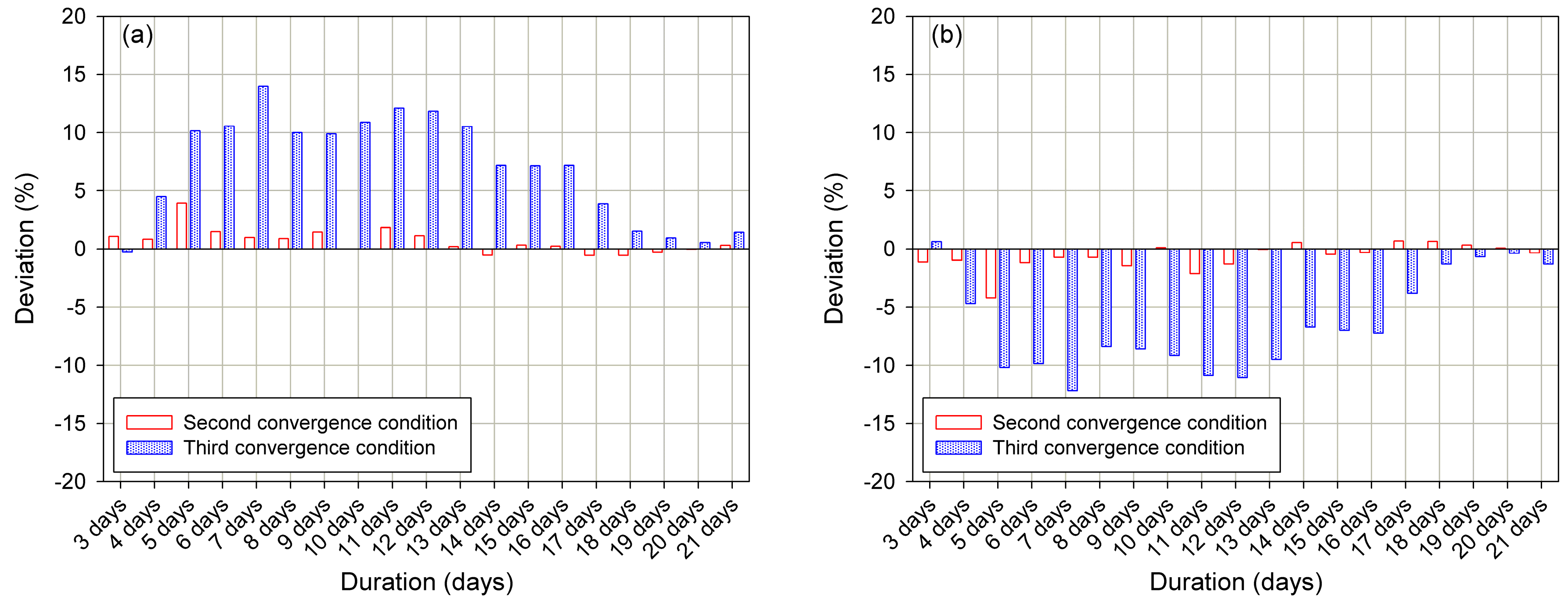
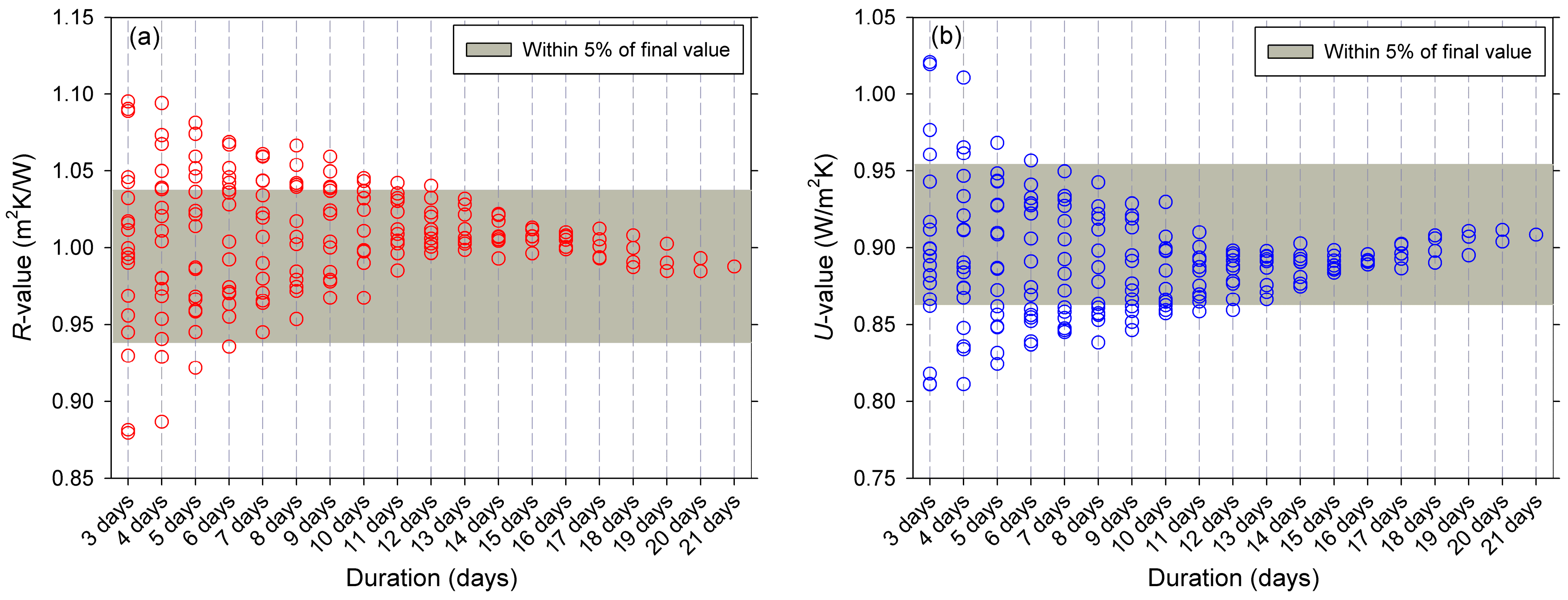
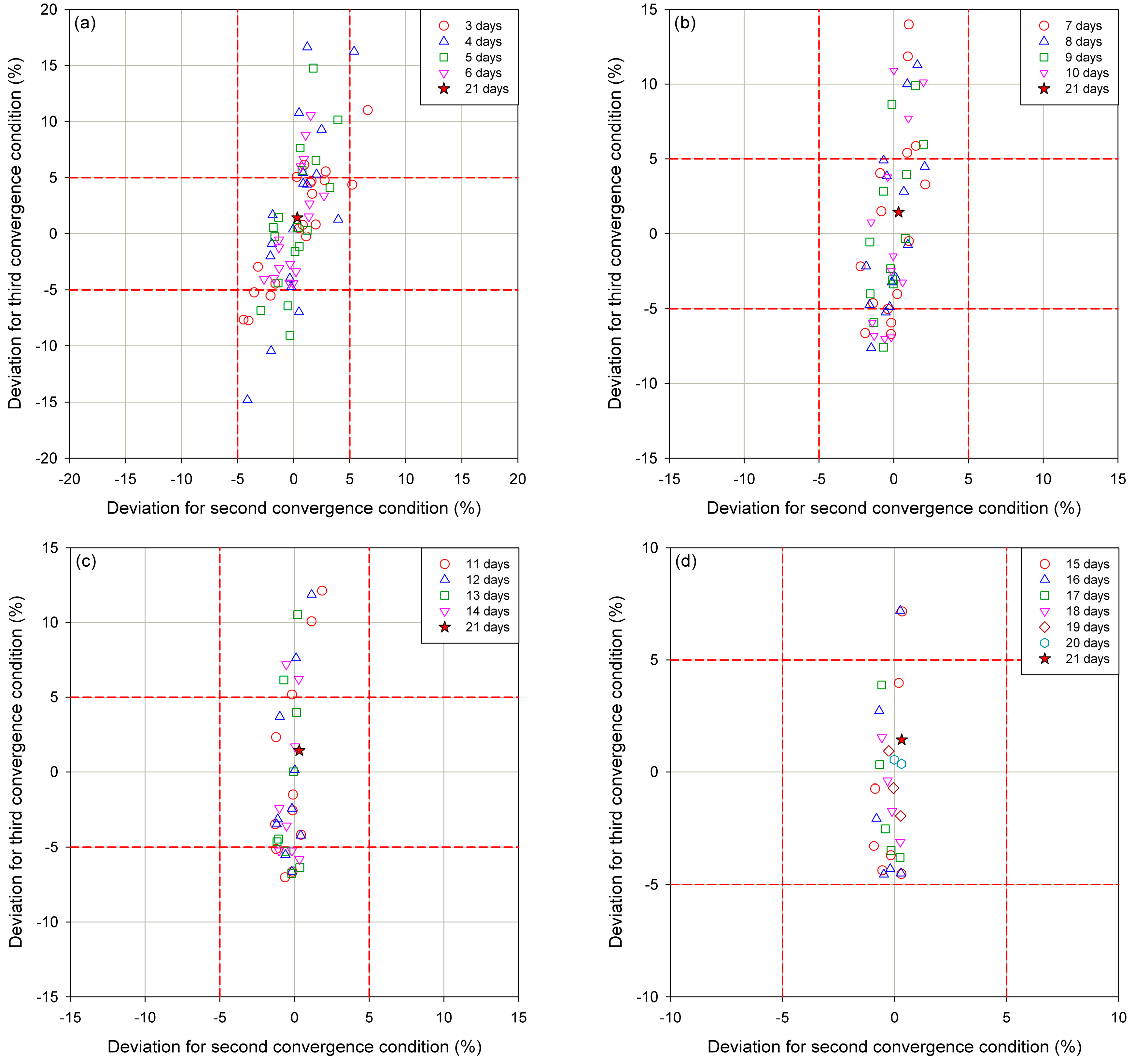
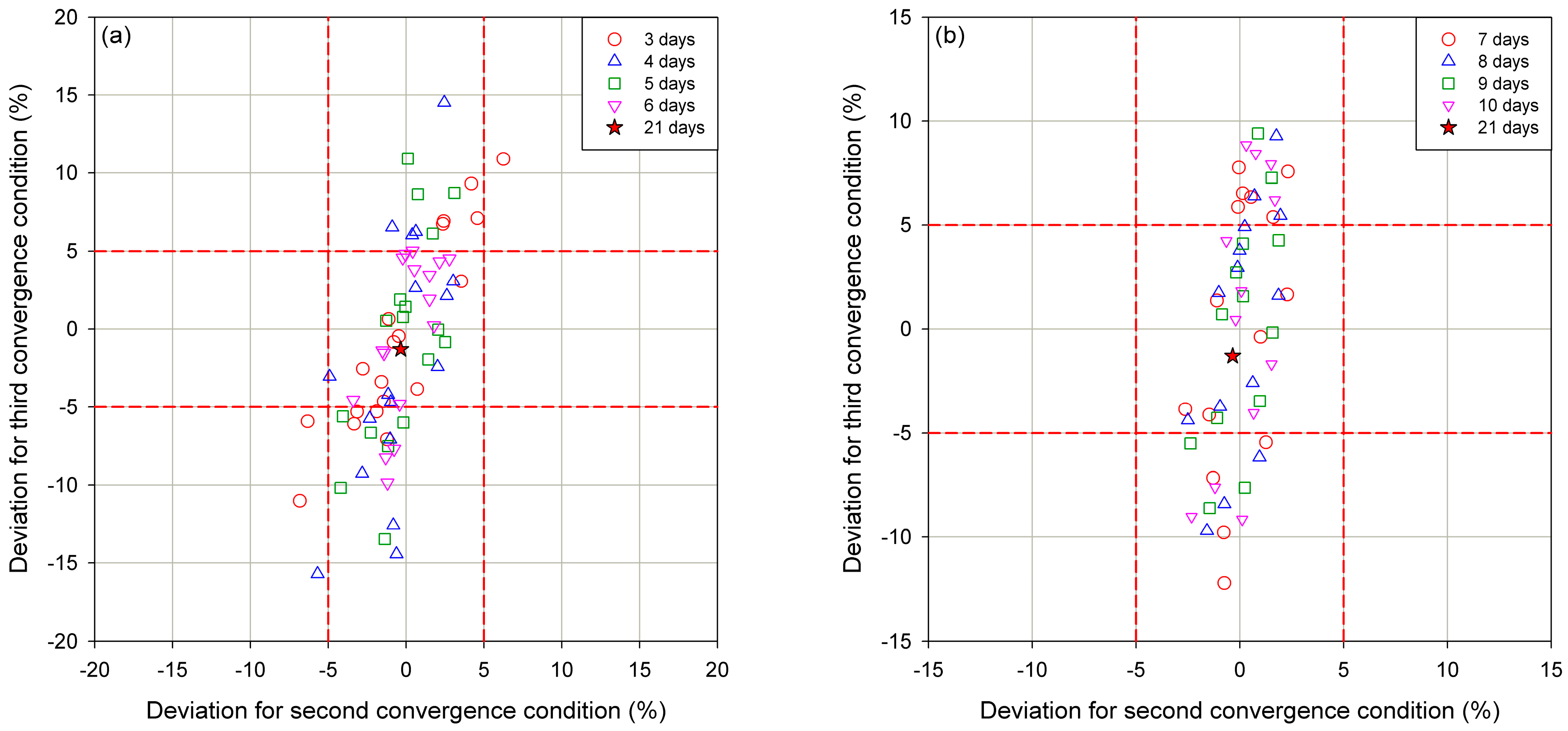
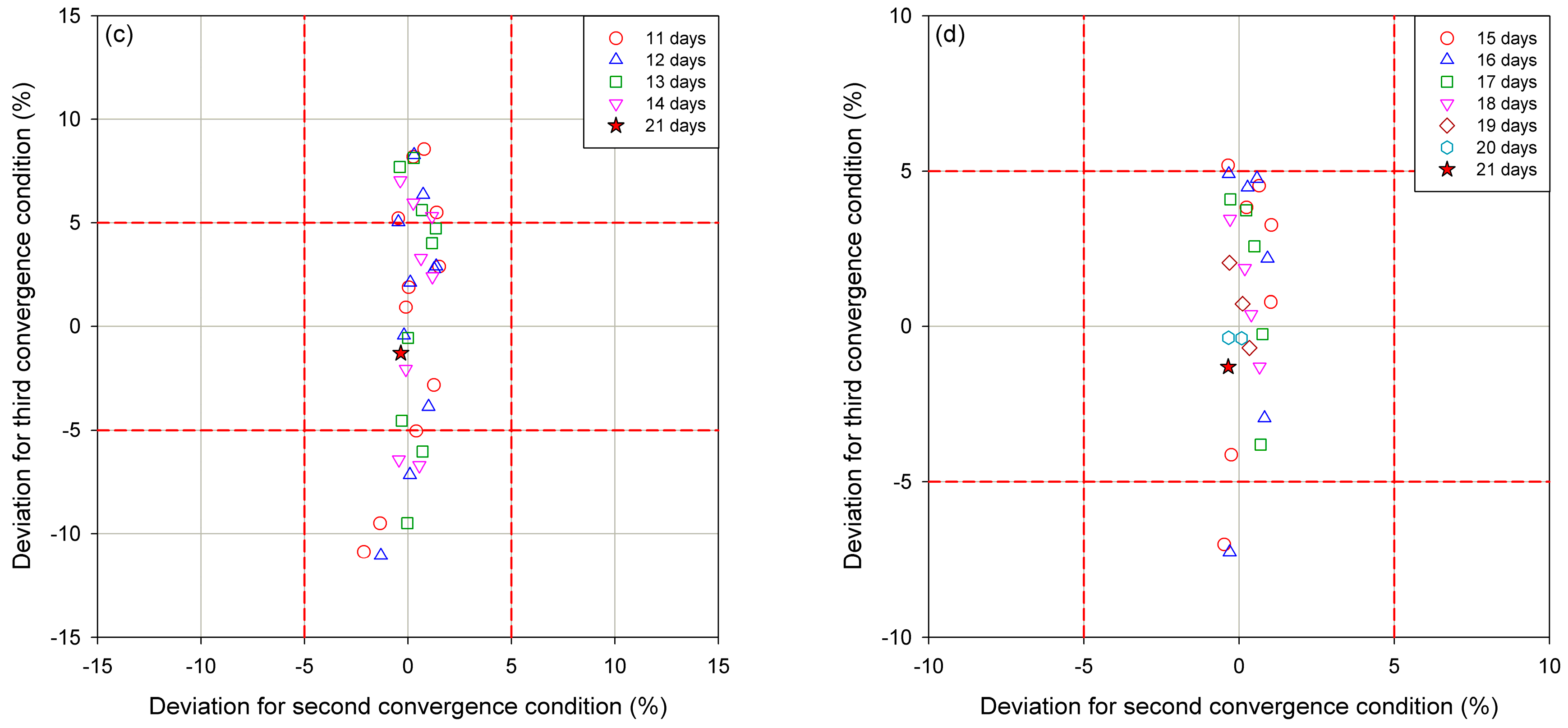
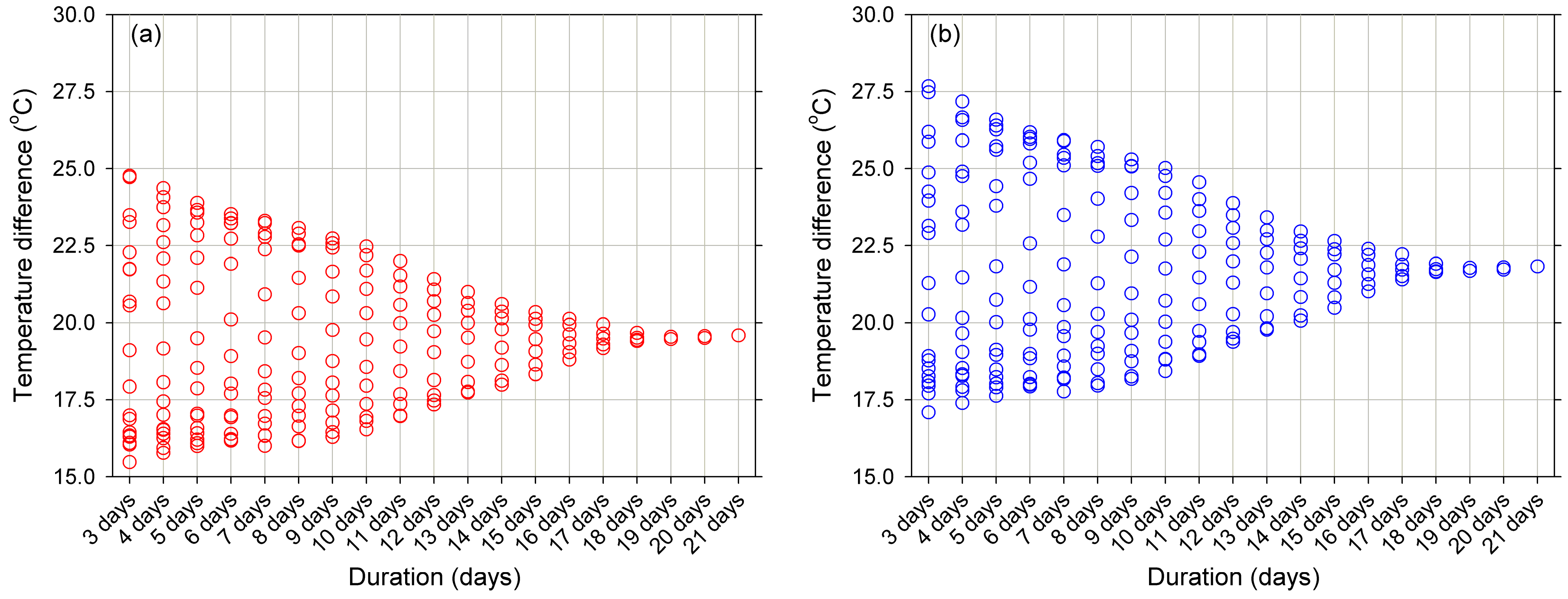
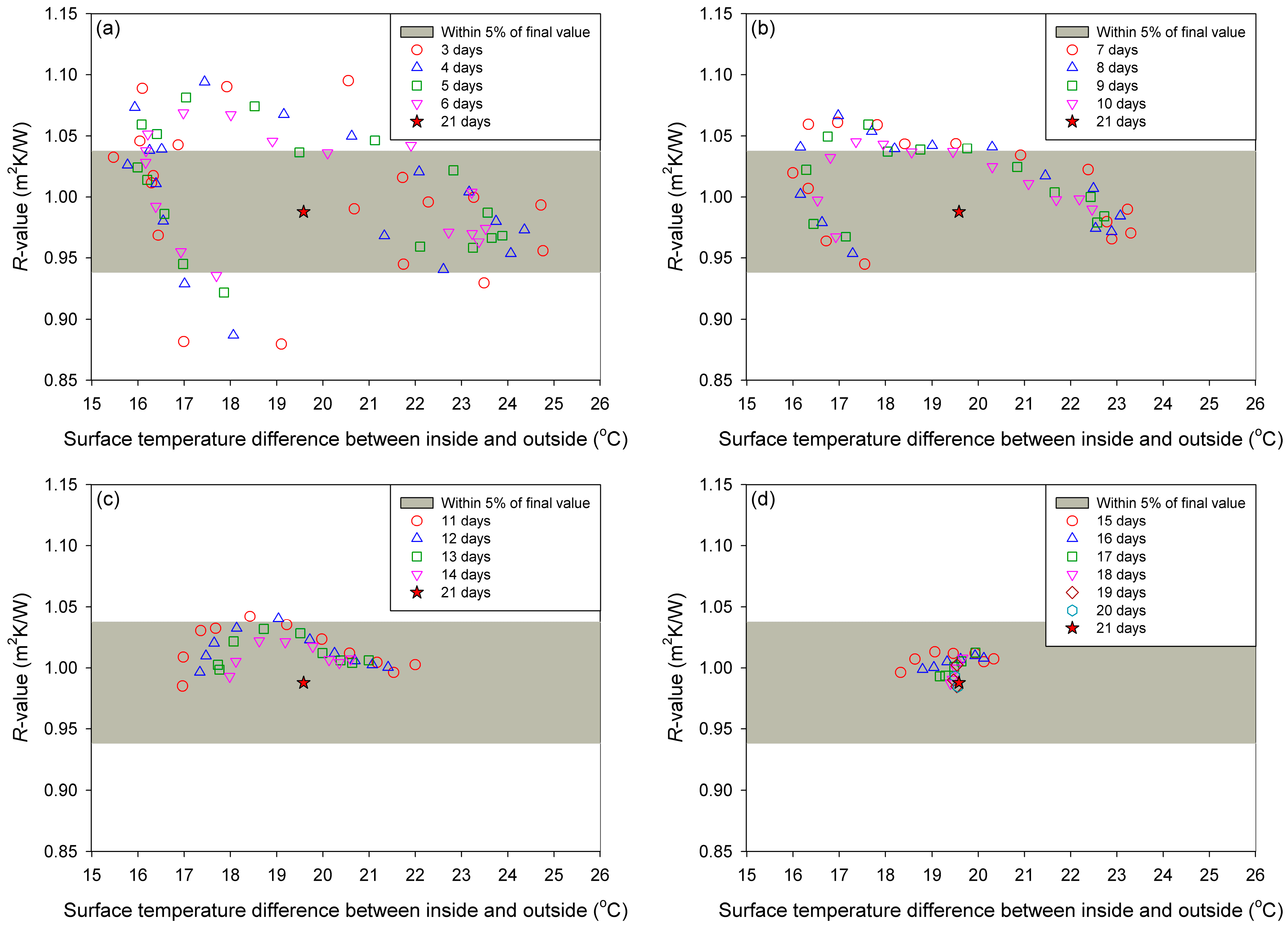
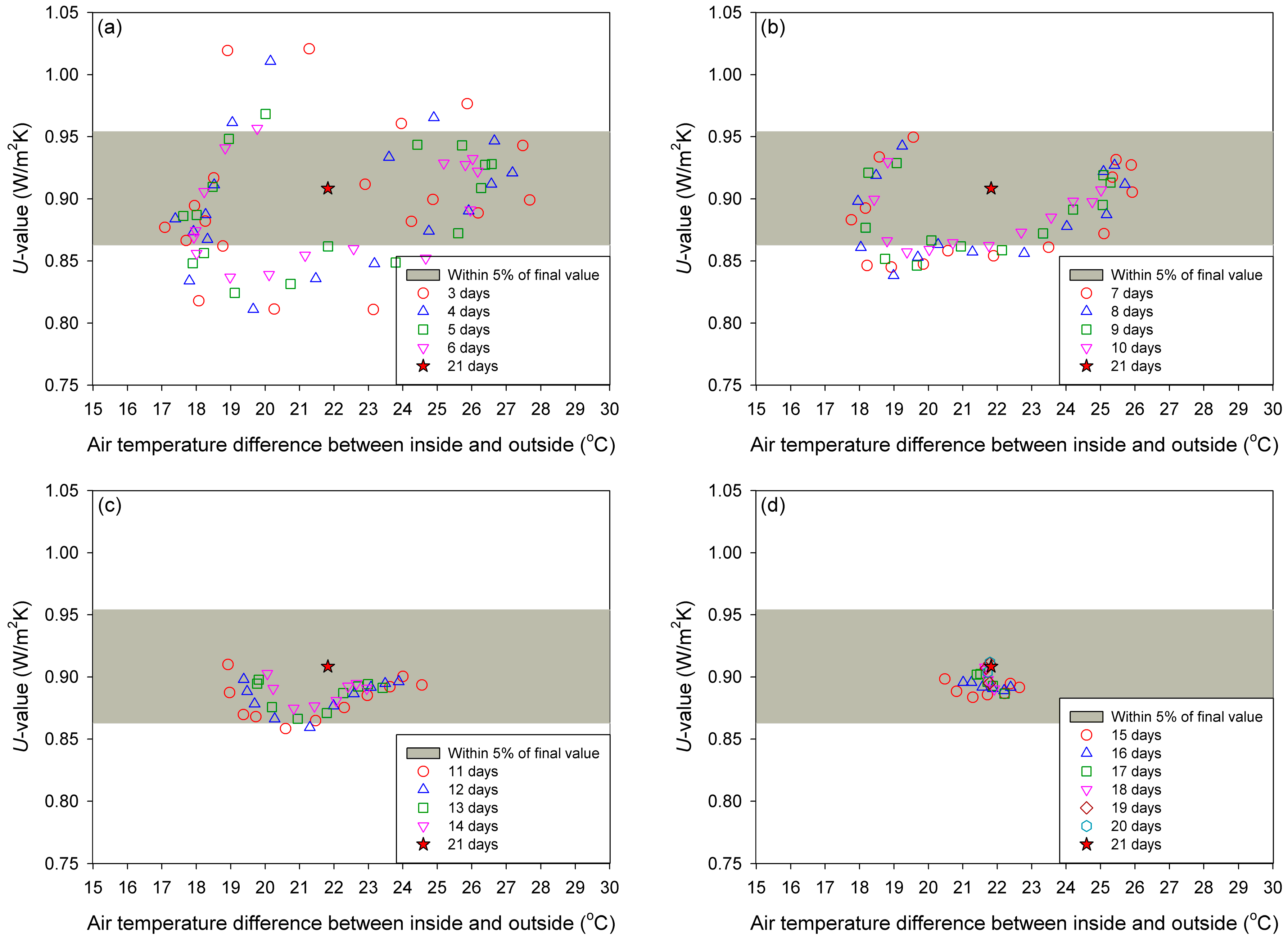
| Material Layer | ||||||
|---|---|---|---|---|---|---|
| Internal surface | 0.110 | 0.460 | ||||
| Mortar | 10 | 1.400 | 2000 | 780 | 0.007 | |
| Cement brick | 90 | 0.600 | 1700 | 835 | 0.150 | |
| Glass wool | 60 | 0.035 | 40 | 670 | 1.714 | |
| Cement brick | 90 | 0.600 | 1700 | 835 | 0.150 | |
| External surface | 0.043 |
| Equipment (model) | Parameter | Range | Accuracy |
|---|---|---|---|
| Heat flux sensor (EKO MF-200) | Heat flux | ±2% | |
| Comfort probe (Testo 0628-0143) | Inside air temperature | 0–50 °C | ±0.5 °C |
| Inside wind speed | 0–5 m/s | ± (0.03 m/s + 4%) | |
| Hot-wire probe (Testo 0635-1543) | Outside air temperature | −20–70 °C | ±0.5 °C |
| Outside wind speed | 0–20 m/s | ±(0.03 m/s + 4%) | |
| Thermocouple (Testo 0602-5792) | Surface temperature | −200–1000 °C | ±(0.5 °C + 0.3%) |
| Pyranometer (EKO MS-602) | Solar radiation | 0–2000 W/m² | <25 W/m² |
| Infrared camera (FLIR T-620) | Thermogram | 7.5–14 μm | ±2 °C |
| Type | Uncertainty Source | Systematic Uncertainty | Random Uncertainty |
|---|---|---|---|
| Instrument | Accuracy of thermocouples | ±0.5 °C 1 | |
| Accuracy of heat flux sensor | 2% 1 | ||
| Accuracy of data logger | 10% 2 | ||
| Thermocouple calibration | ±2.2 °C 1 | ||
| Heat flux sensor calibration | 3% 1 | ||
| Operation | Poor contact between thermocouple and surface | 5% 2 | |
| Poor contact between heat flux sensor and surface | 5% 2 | ||
| Modification of isotherms caused by heat flux sensor | 2%–3% 2 | ||
| Variation in temperatures and heat flux over time | ±10% 2 |
| (days) | R-values with Their Expended Uncertainties (m2·K/W) | ||||
|---|---|---|---|---|---|
| 3 | 2 | 0.879 ± 0.020 | 0.870 ± 0.023 | 0.870 ± 0.023 | 0.868 ± 0.025 |
| 4 | 2 | 0.887 ± 0.018 | 0.879 ± 0.020 | 0.870 ± 0.023 | 0.909 ± 0.029 |
| 5 | 3 | 0.922 ± 0.017 | 0.887 ± 0.018 | 0.879 ± 0.020 | 0.969 ± 0.025 |
| 6 | 4 | 0.936 ± 0.016 | 0.922 ± 0.017 | 0.887 ± 0.018 | 0.980 ± 0.022 |
| 7 | 4 | 0.945 ± 0.015 | 0.936 ± 0.016 | 0.887 ± 0.018 | 1.011 ± 0.023 |
| 8 | 5 | 0.954 ± 0.015 | 0.945 ± 0.015 | 0.922 ± 0.017 | 1.014 ± 0.021 |
| 9 | 6 | 0.967 ± 0.014 | 0.954 ± 0.015 | 0.936 ± 0.016 | 1.028 ± 0.020 |
| 10 | 6 | 0.967 ± 0.013 | 0.967 ± 0.014 | 0.936 ± 0.016 | 1.038 ± 0.020 |
| 11 | 7 | 0.985 ± 0.013 | 0.967 ± 0.013 | 0.945 ± 0.015 | 1.060 ± 0.019 |
| 12 | 8 | 0.996 ± 0.013 | 0.985 ± 0.013 | 0.954 ± 0.015 | 1.067 ± 0.017 |
| 13 | 8 | 0.998 ± 0.012 | 0.996 ± 0.013 | 0.954 ± 0.015 | 1.054 ± 0.016 |
| 14 | 9 | 0.993 ± 0.011 | 0.998 ± 0.012 | 0.967 ± 0.014 | 1.037 ± 0.015 |
| 15 | 10 | 0.996 ± 0.011 | 0.993 ± 0.011 | 0.967 ± 0.013 | 1.037 ± 0.014 |
| 16 | 10 | 0.999 ± 0.010 | 0.996 ± 0.011 | 0.967 ± 0.013 | 1.037 ± 0.013 |
| 17 | 11 | 0.993 ± 0.010 | 0.999 ± 0.010 | 0.985 ± 0.013 | 1.023 ± 0.012 |
| 18 | 12 | 0.987 ± 0.009 | 0.993 ± 0.010 | 0.996 ± 0.013 | 1.012 ± 0.011 |
| 19 | 12 | 0.985 ± 0.009 | 0.987 ± 0.009 | 0.996 ± 0.013 | 1.006 ± 0.011 |
| 20 | 13 | 0.985 ± 0.009 | 0.985 ± 0.009 | 0.998 ± 0.012 | 1.004 ± 0.011 |
| 21 | 14 | 0.988 ± 0.009 | 0.985 ± 0.009 | 0.993 ± 0.011 | 1.007 ± 0.010 |
| (days) | U-values with Their Expended Uncertainties (W/ m2·K) | ||||
|---|---|---|---|---|---|
| 3 | 2 | 1.021 ± 0.022 | 1.032 ± 0.026 | 1.032 ± 0.026 | 1.039 ± 0.029 |
| 4 | 2 | 1.011 ± 0.020 | 1.021 ± 0.022 | 1.032 ± 0.026 | 0.984 ± 0.030 |
| 5 | 3 | 0.968 ± 0.017 | 1.011 ± 0.020 | 1.021 ± 0.022 | 0.917 ± 0.022 |
| 6 | 4 | 0.957 ± 0.015 | 0.968 ± 0.017 | 1.011 ± 0.020 | 0.911 ± 0.019 |
| 7 | 4 | 0.950 ± 0.014 | 0.957 ± 0.015 | 1.011 ± 0.020 | 0.887 ± 0.019 |
| 8 | 5 | 0.942 ± 0.013 | 0.950 ± 0.014 | 0.968 ± 0.017 | 0.887 ± 0.017 |
| 9 | 6 | 0.929 ± 0.013 | 0.942 ± 0.013 | 0.957 ± 0.015 | 0.874 ± 0.015 |
| 10 | 6 | 0.930 ± 0.012 | 0.929 ± 0.013 | 0.957 ± 0.015 | 0.869 ± 0.015 |
| 11 | 7 | 0.910 ± 0.011 | 0.930 ± 0.012 | 0.950 ± 0.014 | 0.846 ± 0.014 |
| 12 | 8 | 0.898 ± 0.010 | 0.910 ± 0.011 | 0.942 ± 0.013 | 0.838 ± 0.012 |
| 13 | 8 | 0.898 ± 0.010 | 0.898 ± 0.010 | 0.942 ± 0.013 | 0.853 ± 0.012 |
| 14 | 9 | 0.903 ± 0.010 | 0.898 ± 0.010 | 0.929 ± 0.013 | 0.866 ± 0.011 |
| 15 | 10 | 0.898 ± 0.009 | 0.903 ± 0.010 | 0.930 ± 0.012 | 0.865 ± 0.011 |
| 16 | 10 | 0.896 ± 0.009 | 0.898 ± 0.009 | 0.930 ± 0.012 | 0.862 ± 0.010 |
| 17 | 11 | 0.902 ± 0.008 | 0.896 ± 0.009 | 0.910 ± 0.011 | 0.875 ± 0.010 |
| 18 | 12 | 0.908 ± 0.008 | 0.902 ± 0.008 | 0.898 ± 0.010 | 0.886 ± 0.009 |
| 19 | 12 | 0.911 ± 0.008 | 0.908 ± 0.008 | 0.898 ± 0.010 | 0.892 ± 0.009 |
| 20 | 13 | 0.912 ± 0.008 | 0.911 ± 0.008 | 0.898 ± 0.010 | 0.894 ± 0.009 |
| 21 | 14 | 0.908 ± 0.007 | 0.912 ± 0.008 | 0.903 ± 0.010 | 0.891 ± 0.009 |
© 2019 by the authors. Licensee MDPI, Basel, Switzerland. This article is an open access article distributed under the terms and conditions of the Creative Commons Attribution (CC BY) license (http://creativecommons.org/licenses/by/4.0/).
Share and Cite
Choi, D.S.; Ko, M.J. Analysis of Convergence Characteristics of Average Method Regulated by ISO 9869-1 for Evaluating In Situ Thermal Resistance and Thermal Transmittance of Opaque Exterior Walls. Energies 2019, 12, 1989. https://doi.org/10.3390/en12101989
Choi DS, Ko MJ. Analysis of Convergence Characteristics of Average Method Regulated by ISO 9869-1 for Evaluating In Situ Thermal Resistance and Thermal Transmittance of Opaque Exterior Walls. Energies. 2019; 12(10):1989. https://doi.org/10.3390/en12101989
Chicago/Turabian StyleChoi, Doo Sung, and Myeong Jin Ko. 2019. "Analysis of Convergence Characteristics of Average Method Regulated by ISO 9869-1 for Evaluating In Situ Thermal Resistance and Thermal Transmittance of Opaque Exterior Walls" Energies 12, no. 10: 1989. https://doi.org/10.3390/en12101989
APA StyleChoi, D. S., & Ko, M. J. (2019). Analysis of Convergence Characteristics of Average Method Regulated by ISO 9869-1 for Evaluating In Situ Thermal Resistance and Thermal Transmittance of Opaque Exterior Walls. Energies, 12(10), 1989. https://doi.org/10.3390/en12101989





